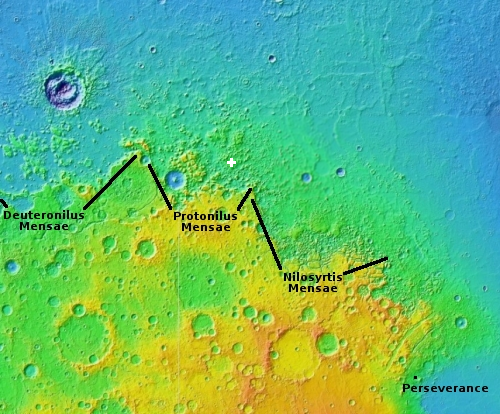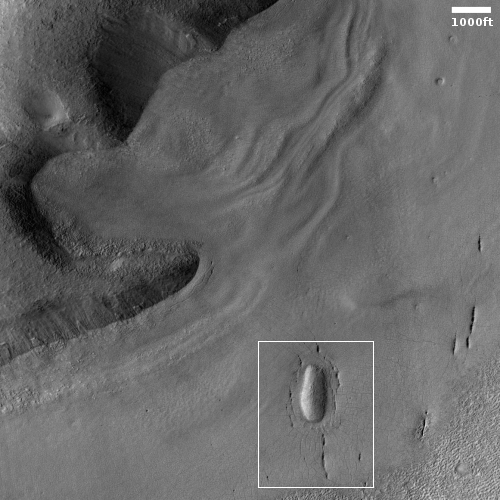Cracking glaciers on Mars
Cool image time! The photo to the right, cropped and reduced to post here, was released today as the picture of the day for the high resolution camera on Mars Reconnaissance Orbiter (MRO). Located in the 2,000 long northern mid-latitude strip that I dub Mars’ glacier country, it shows many of the numerous glacial features that are routinely found in images taken in this region. According to Dan Berman, senior scientist at the Planetary Science Institute in Arizona, who wrote the caption,
This observation shows a lobe-shaped debris apron emanating from a massif (shown in the upper left of the image) in the Protonilus Mensae region in the Northern Hemisphere of Mars. These aprons are composed of nearly pure water ice with a layer of debris on the surface protecting the ice from sublimation (going directly from a solid to gaseous state). This image shows different terrain types on the apron that indicate the presence and flow of ice, from smoother polygonal terrain closer to the massif, to rougher, patterned ground commonly called “brain terrain.” Also visible on the apron are a series of linear pits.
Protonilus Mensae is the central mensae region in that mid-latitude strip of glaciers.The overview map below shows the location of this photo in that region. Also below is a close-up of the linear pits and cracked terrain surrounding that oblong mound, as indicated by the white rectangle.

The white cross marks the location of the photo above. If you do a search on Behind the Black for “glaciers” or “glacier country,” you will find numerous images in this region, all showing similar glacial terrain. The latitude of the region ranges from 30 to 47 degrees, with this particular spot at 44 degrees. At that latitude almost every low spot will show glacial features, as noted by Berman above.
The close-up of the area in the rectangle is also to the right. The many polygonal cracks and linear pits surrounding this mound suggest that the buried glaciers at this location are sublimating away. Think of the polygonal cracks that appear in drying mud. A similar phenomenon is occurring here. At the ice sublimates into gas, the remaining solid ice cracks and shrinks, producing cracks and voids. In some cases the voids become large enough that they form the linear pits that surround this mound.
This pits are also comparable to the rifts and cracks that mountain climbers must deal with when they need to traverse Earth glaciers. The difference is that on Earth those glaciers are very active, with the ice moving and new cracks forming regularly.
On Mars these glaciers are thought to be no longer growing or moving. If any change is occurring it is sublimation and shrinking, though it remains unclear whether the glaciers in Mars’ mid-latitudes are in an overall steady state, or are growing or shrinking.
On Christmas Eve 1968 three Americans became the first humans to visit another world. What they did to celebrate was unexpected and profound, and will be remembered throughout all human history. Genesis: the Story of Apollo 8, Robert Zimmerman's classic history of humanity's first journey to another world, tells that story, and it is now available as both an ebook and an audiobook, both with a foreword by Valerie Anders and a new introduction by Robert Zimmerman.
The print edition can be purchased at Amazon or from any other book seller. If you want an autographed copy the price is $60 for the hardback and $45 for the paperback, plus $8 shipping for each. Go here for purchasing details. The ebook is available everywhere for $5.99 (before discount) at amazon, or direct from my ebook publisher, ebookit. If you buy it from ebookit you don't support the big tech companies and the author gets a bigger cut much sooner.
The audiobook is also available at all these vendors, and is also free with a 30-day trial membership to Audible.
"Not simply about one mission, [Genesis] is also the history of America's quest for the moon... Zimmerman has done a masterful job of tying disparate events together into a solid account of one of America's greatest human triumphs."--San Antonio Express-News
Cool image time! The photo to the right, cropped and reduced to post here, was released today as the picture of the day for the high resolution camera on Mars Reconnaissance Orbiter (MRO). Located in the 2,000 long northern mid-latitude strip that I dub Mars’ glacier country, it shows many of the numerous glacial features that are routinely found in images taken in this region. According to Dan Berman, senior scientist at the Planetary Science Institute in Arizona, who wrote the caption,
This observation shows a lobe-shaped debris apron emanating from a massif (shown in the upper left of the image) in the Protonilus Mensae region in the Northern Hemisphere of Mars. These aprons are composed of nearly pure water ice with a layer of debris on the surface protecting the ice from sublimation (going directly from a solid to gaseous state). This image shows different terrain types on the apron that indicate the presence and flow of ice, from smoother polygonal terrain closer to the massif, to rougher, patterned ground commonly called “brain terrain.” Also visible on the apron are a series of linear pits.
Protonilus Mensae is the central mensae region in that mid-latitude strip of glaciers.The overview map below shows the location of this photo in that region. Also below is a close-up of the linear pits and cracked terrain surrounding that oblong mound, as indicated by the white rectangle.

The white cross marks the location of the photo above. If you do a search on Behind the Black for “glaciers” or “glacier country,” you will find numerous images in this region, all showing similar glacial terrain. The latitude of the region ranges from 30 to 47 degrees, with this particular spot at 44 degrees. At that latitude almost every low spot will show glacial features, as noted by Berman above.
The close-up of the area in the rectangle is also to the right. The many polygonal cracks and linear pits surrounding this mound suggest that the buried glaciers at this location are sublimating away. Think of the polygonal cracks that appear in drying mud. A similar phenomenon is occurring here. At the ice sublimates into gas, the remaining solid ice cracks and shrinks, producing cracks and voids. In some cases the voids become large enough that they form the linear pits that surround this mound.
This pits are also comparable to the rifts and cracks that mountain climbers must deal with when they need to traverse Earth glaciers. The difference is that on Earth those glaciers are very active, with the ice moving and new cracks forming regularly.
On Mars these glaciers are thought to be no longer growing or moving. If any change is occurring it is sublimation and shrinking, though it remains unclear whether the glaciers in Mars’ mid-latitudes are in an overall steady state, or are growing or shrinking.
On Christmas Eve 1968 three Americans became the first humans to visit another world. What they did to celebrate was unexpected and profound, and will be remembered throughout all human history. Genesis: the Story of Apollo 8, Robert Zimmerman's classic history of humanity's first journey to another world, tells that story, and it is now available as both an ebook and an audiobook, both with a foreword by Valerie Anders and a new introduction by Robert Zimmerman.
The print edition can be purchased at Amazon or from any other book seller. If you want an autographed copy the price is $60 for the hardback and $45 for the paperback, plus $8 shipping for each. Go here for purchasing details. The ebook is available everywhere for $5.99 (before discount) at amazon, or direct from my ebook publisher, ebookit. If you buy it from ebookit you don't support the big tech companies and the author gets a bigger cut much sooner.
The audiobook is also available at all these vendors, and is also free with a 30-day trial membership to Audible.
"Not simply about one mission, [Genesis] is also the history of America's quest for the moon... Zimmerman has done a masterful job of tying disparate events together into a solid account of one of America's greatest human triumphs."--San Antonio Express-News



